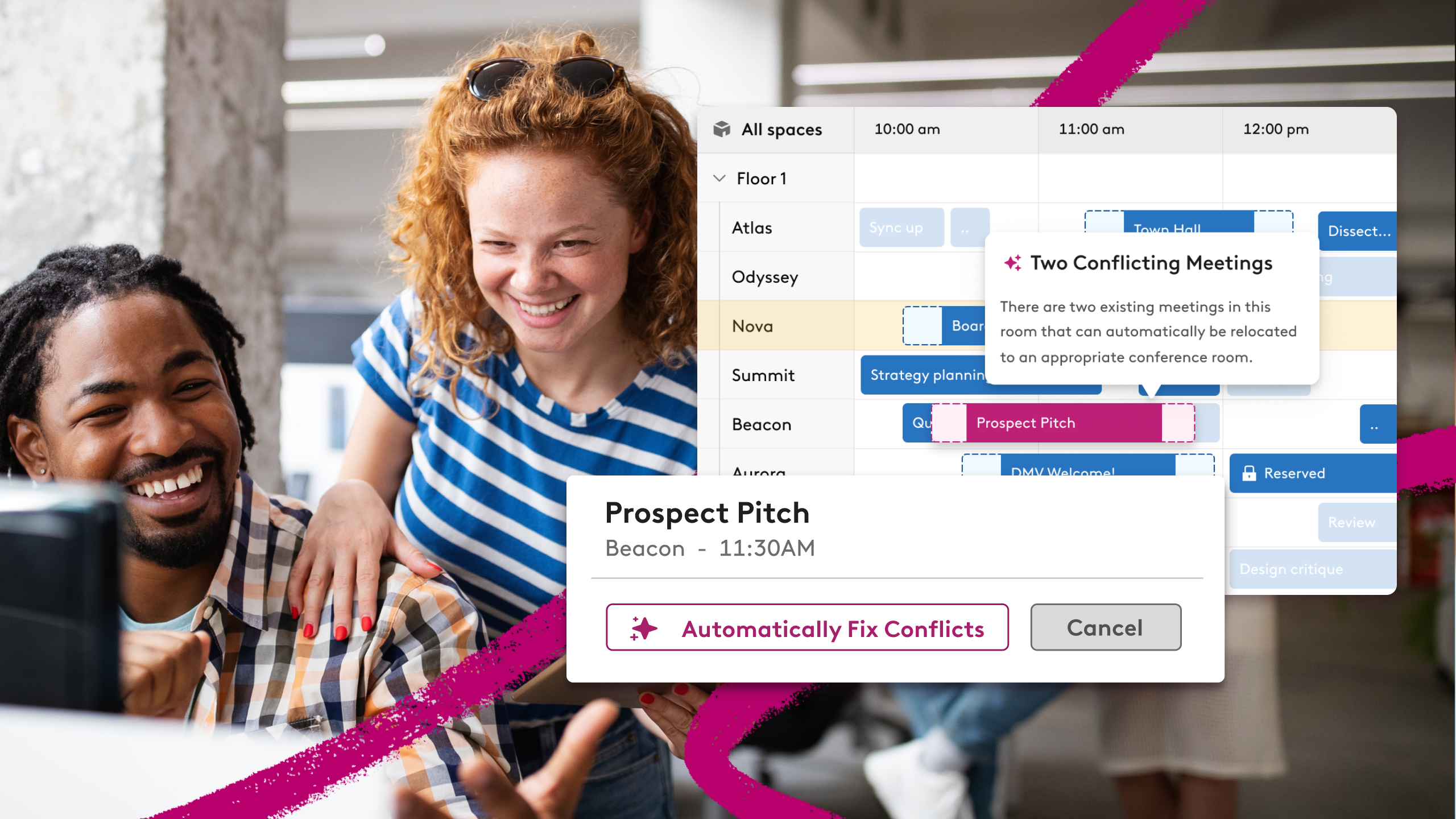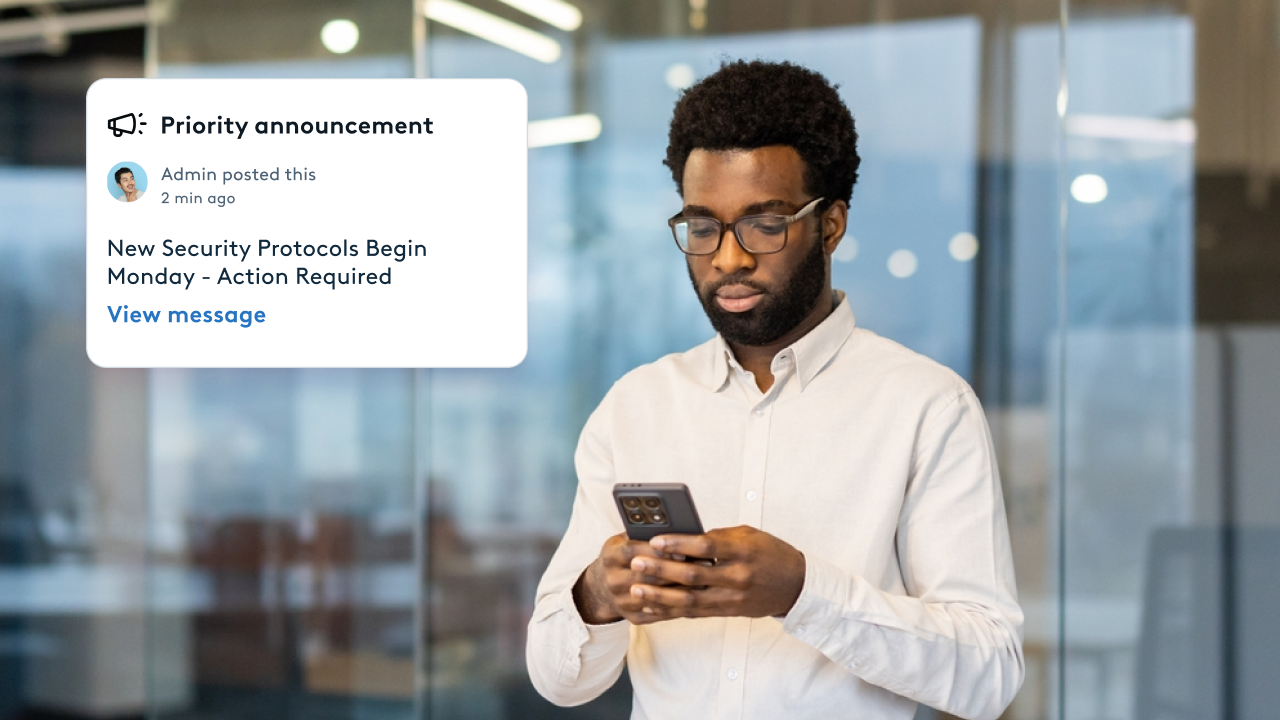How to Plan for a New Office Space

Building a physical space in which your people can do their best work is the goal of every workplace leader, but it’s never been more challenging than today. We’ve just experienced an intense three-year period of unprecedented workplace change, transforming how people and organizations think about where and how work happens.
In order to decide what your people need and to optimize any new or existing office space, you’ll need a deep understanding of:
- Your commercial real estate, office equipment, furniture, and other physical assets
- Your employee's needs over time, which you can measure based on qualitative data/feedback and workplace analytics
- Your workplace technology and how it supports people’s productivity, while enhancing their employee experience and the optimization of your commercial space
With so many organizations now implementing a flexible workplace strategy, one that typically includes hybrid work (where people are required to come into the office 2-4 days per week), the office setups of the past just don’t make good business sense anymore. This blog post will help you build new offices that meet the demands of today and tomorrow.
When it comes to how you set up your office space, what’s at stake? Everything, including:
- Workplace experience – impacting employee productivity, retention, collaboration, company culture, innovation, and more
- Office utilization – impacting your CRE costs and your operational bottom line
- Your readiness to accommodate future changes

A Brief History of The Traditional Office
What comes to mind when you hear “traditional office space?”
Probably a gray, suburban office building with stale cubicles or metal desks arranged in rows under dull, fluorescent lighting. People come in around 9am, after fighting rush-hour traffic, and leave around 5pm, repeating the same pattern every weekday until the much-welcomed arrival of the weekend, when all the square footage and private offices are sitting vacant. In terms of the timing, it could be 1948, 1974, or 2006 – it’s largely the same 9-to-5 workplace “vibe” with slight differences.
In the traditional office, people (sometimes referred to as “personnel” or “human resources”) have limited flexibility, with most workers required to follow strict company policies and procedures around when and where to work. Most employees have a designated desk or cubicle and a manager who monitors their performance, often by walking the hallways. The company culture may have included specific values and slogans posted on the walls (“We work hard here!”) and a dress code that may have (if you were lucky) allowed for “casual Friday” or “Hawaiian shirt day” in the summertime.
Did these traditional office spaces create great employee experiences and optimize people’s productivity? Not exactly. As Peter Gibbons says in the film “Office Space,” a great explainer of the traditional office buildings of the late 1990s: “human beings were not meant to sit in little cubicles, staring at computer screens all day, filling out useless forms.”

The Current State of Office Space
After three years of constant, pandemic-induced workplace change, companies have been calling their teams back in the form of return to office policies. Robin’s 2023 Office Space Report shows that 88% of companies mandate employees work a certain number of days per week in the office. But that doesn’t mean we’re going back to the traditional office of the past.
That same Robin report shows that 75% of businesses plan to reduce office square footage in 2024. Among those that plan to downsize, 69% report that they'll reduce their current space by 50% or more. That’s a tremendous amount of change.
Today’s office spaces need to accommodate how people work best, supporting flexible work schedules (e.g., hybrid work) with flexible workspace approaches. For instance, desks may not be assigned to specific individuals, but instead are made bookable by anyone on any day they might be needed. People want a flexible office design and layout with, for example, a mixture of conference rooms and meeting rooms of different sizes for different functions.
Planning for a New Office Space
As with all things related to the commercial real estate market, everything begins with location, location, location. When you start the process of planning a new office space, begin by meticulously scoping out the location of your planned new office and understanding how its location impacts the needs of your organization and your people.
Is your office located near or far from where most of your people and potential office tenants and clients live? If your location is hard to reach, you might have to hire more remote workers.

Is your office in a busy city center, perhaps easy to access by public transit, or in a suburban office park near the interstate where the rent is cheaper, but maybe far from good restaurants and other amenities (the rent is usually cheaper for a reason)? How about parking options?
How large is your commercial footprint and what are the logistics involved in moving your people and business assets to the new location? What will the people inside the new offices be doing? Will your people be performing administrative work, sales, or production work (which may require more machines)?
Office Resources
Moving, whether at a personal level or at the organizational level, is always a challenge, in terms of planning, logistics, and executing the move. Make an audit of what needs to be moved and then have a plan for where you’ll put everything in the new office space. How many desks, chairs, rooms, cables, routers, and other amenities will you need to put in the new office space?
Consider making a list of all the resources your people will need in the early stages of the new office space, and don’t worry about whether you’ve planned for everything. You haven’t. Once people have moved into the space, take advantage of the first few weeks and months to remain open to, and accommodate, all the unanticipated needs people will have.
PS: We created a free office move checklist so you can stay organized during future moves, check it out.
Enabling Flexibility: Workplace Layouts
Robin’s 2023 Office Space Report notes that 89% of offices are planning to change their layout or workplace design in order to support new and evolving employee demands. Workplace leaders now understand that flexible office layouts and designs are necessary for supporting flexible ways of working.
People want spaces that fit how they might want to work during the day. Offices need meeting rooms of different sizes that enable collaboration, from a small conference room to a 200-seat auditorium for all-hands meetings. But they also need:
- Desks that are well-equipped with the right technology
- Spaces for socializing with team members
- Areas dedicated to well-being and quiet time
- And more!

When Robin asked what spaces their office will offer to accommodate how people want to work, workplace leaders mentioned:
- Soft seating/lounges with comfortable furniture (60%)
- Collaboration/huddle rooms (58%)
- Quiet rooms/booths (54.31%)
- Spaces that support wellness and employee well-being (53.18%)
- Hot desking (52.81%)
What should the layout of your new space look like? Well, it depends on the needs of your people. Ask them how they prefer to work and what they need to support that. Be ready to evolve your workspace approach depending on the needs of your people and utilize qualitative and quantitative data/workplace analytics to inform changes in your workspace.
Enabling Flexibility: The Role of Workplace Technology
Workplace technologies such as desk and meeting room booking software support flexible ways of working – in terms of both scheduling and workspace flexibility – by enabling people to (1) view in real-time what desks and meeting spaces are available and (2) reserve them, as well as relevant equipment, according to their needs.
Workplace technologies also share utilization data with workplace leaders so they have full visibility into how office spaces are being used, enabling said leaders to evolve their workplace approaches in data-driven ways. In short, today’s workplace is complex and must be built in a manner that enables people and organizations to flexibly address their evolving needs.
What Specific Technology Do You Need?
The answer depends on what your people do and how they use spaces to work/collaborate, but some obvious tech needs would include:
1. Resource booking solutions
Space booking software gives your people full visibility into all available desks and meeting rooms, so they can quickly reserve the spaces they need. Booking technology also allows workplace leaders to collect and monitor office utilization rates/workplace analytics so they can make better decisions about future office space planning and resource allocations that drive improved workplace satisfaction.

2. High-speed WiFi and Tech for Hybrid Meetings
If some of your people work remotely, they’ll need to connect with people working in the office. Hybrid meetings, for example, are commonplace and use technology to enable onsite and remote employees to collaborate in real-time. You’d clearly need good cameras, microphones, and wi-fi connections to enable any hybrid meeting.
Without the hardware, software, and systems that enable people to connect from anywhere, hybrid work and collaboration among distributed teams would be impossible.
3. A Visitor Management System
Your suppliers, potential investors, and would-be/existing clients will want to visit your office space in order to strengthen business relationships. You need to make them feel welcome and allow them to easily navigate your space with, for example, a visitor management system with good wayfinding solutions and smooth check-in.
More visitors are coming. US offices have seen a 147% increase in guest visits since January of 2023, according to our Office Trends Report: H1 2023.When a visitor’s experience is managed well, visitors add value to your business. On the other hand, when visitors are forced to roam around asking random employees for help, it wastes people’s productivity and money, frustrates visitors, and may even jeopardize your security.

The Future Workplace is Intelligent
None of us have a crystal ball, but we know rapid change can come and utterly transform where and how work happens. That uncertainty means that organizations must be ever-ready for change and prepared to pivot on a dime.
The future of the office, like the present, will be a flexible one, one that can identify change as it happens and adjust along with it. At Robin, we call it the intelligent workplace – an office ecosystem that uses data to sense change and respond to it appropriately.
We’re honored to be co-creating the future of workspace design with you, and we exist to help you from here to there. Reach out to us today for help!












